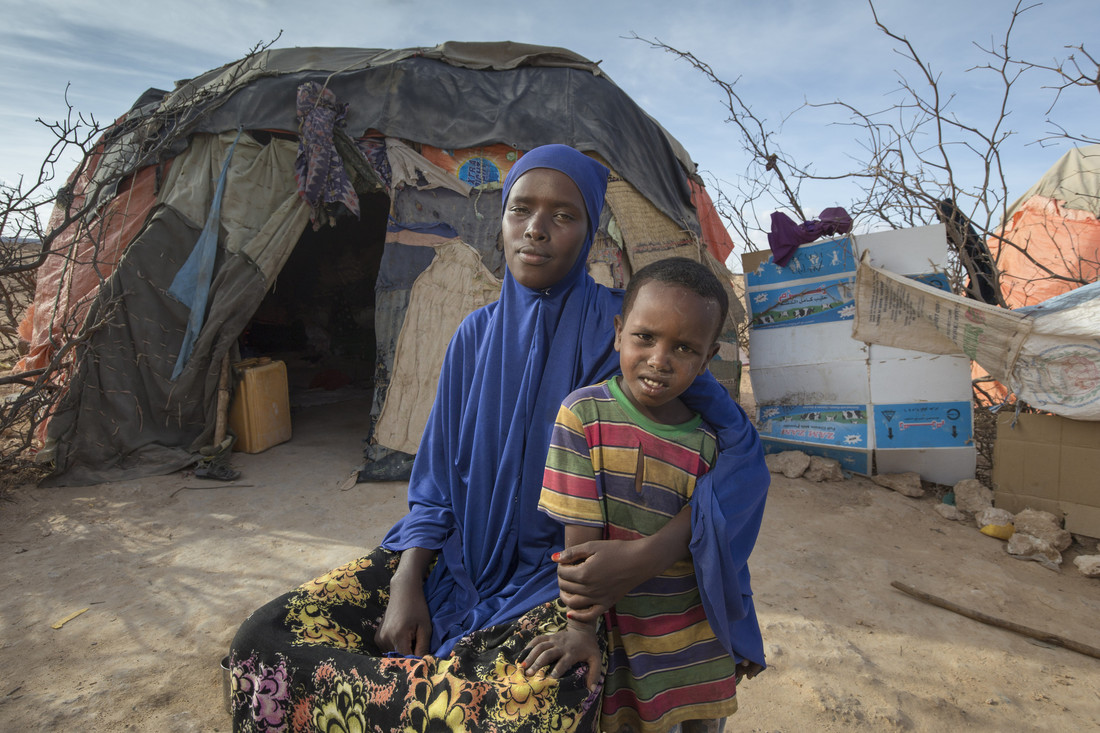Is the food movement “America First”?
 Ayan with her son Mohammed* outside of their home in the town of Garadag, Somalia in a settlement for people internally displaced. Ayan is the mother of Mohammed*, 4 years old. She lost a son because of the drought. She said that her husband is not here at the moment, as three weeks ago he had to take his mother to hospital in Burgo. Ayan’s mother in law is very sick with fever and diarrhea. She was very weak, as the food they have had available in the last few months was scarce. *Name has been changed
Ayan with her son Mohammed* outside of their home in the town of Garadag, Somalia in a settlement for people internally displaced. Ayan is the mother of Mohammed*, 4 years old. She lost a son because of the drought. She said that her husband is not here at the moment, as three weeks ago he had to take his mother to hospital in Burgo. Ayan’s mother in law is very sick with fever and diarrhea. She was very weak, as the food they have had available in the last few months was scarce. *Name has been changed
The US food movement cares about a lot of things, but people outside the US isn’t one of them.
I’m a foodie. I love it – all the food fetishism, coffee, eating local, seasonal. I like the celebrity chefs, the cooking shows, the food travel adventures. Aziz Ansari. All the books about cod, and salt, and spices. All of it.
The food movement is big and vibrant and consequential. It’s definitely more than faddism and savoring good food. I don’t think it’s a passing thing. Food is a prism for society; a way to look at issues of justice, the environment, and fairness through the most basic, but also pleasurable, human needs. But as important as the food movement is, one of my pet rants is about how the food movement is politically irrelevant. Politicians don’t worry about foodies.
Recently, there have been signs of life for the political food movement. Among them is the formation of food policy action which targets legislation and legislators; There are manifestos, and election-outreach initatives.
This more political food movement is tackling challenges throughout the food system, from “farm to fork”, as it were. The food movement sees the challenge as multi-dimensional and brings systemic approaches to the problems; it’s not one thing or another. That’s fantastic. But there’s a gaping hole in the multi-dimensional, systemic approach to the challenge of good food: the rest of the world!
To me, it’s startling how sophisticated the US food movement can be, yet how myopic it also is; virtually ignoring the other 7 billion food consumers and 2.5 billion food producers that occupy the rest of the planet. For example, the most acute food system challenge in the world right now is the horrible fact that 30 million are facing extreme hunger and 10 million are on the verge of famine. I’ll spare you the grim and heart-rending photos of skinny infants and worried mothers in South Sudan, Yemen, Somalia, and Nigeria. But in my world, this is a screaming 4-alarm fire, demanding action from all quarters. To my mind, a “food movement” worth its name would embrace this emergency and help to mobilize.
But this historic threat of famine is nearly invisible in the US food movement. The movement’s pillars are silent or nearly so. Nothing here, or here, or here, or here. Just a bit here.
Don’t get me wrong. There’s a lot wrong with the food system in the US. And, fixing the US food system is actually not a bad place to start fixing the global food system. But I don’t think you can fix the US food system in isolation of the global food system. Given how big the US is, it’s also hard to imagine a better global food system without improving the US food system. The US food system affects – and is affected by – the global food system in numerous ways. Trade, migration, regulation, weather, consumer tastes, technologies all cross borders and have powerful impacts, here and there.
And, in fairness, the internationalists within the global food movement often don’t work with or coordinate with the more domestic-oriented activists. The former are often humanitarians, focused on dealing with emergencies, with hunger crises rather than working on longer-term, systemic solutions. Likewise, humanitarians are often absent from broader movement-building and solidarity. But the vision of a just, abundant, sustainable, and delicious food future is universal. And I think we can – and should – be fighting for the pastoralists in northern Kenya as well as the start-up farmers in the Hudson Valley, for Deqa as well as Myrna. Can’t we combine these struggles? Don’t they complement and strengthen one another?
As a political matter, international hunger, nutrition, and agriculture programs are pretty small potatoes in the US. The whole portfolio is – maybe $4 or $5 billion annually. Compare that just to the US food stamps program, which is $70 billion. But the benefits of the international programs are pretty big – about 40 million people receive food assistance, 9 million farmers have received training and tools to boost their harvests. And making the global food system better, more just, and more sustainable can have very positive benefits for the US. “America First” shouldn’t mean “America only”.